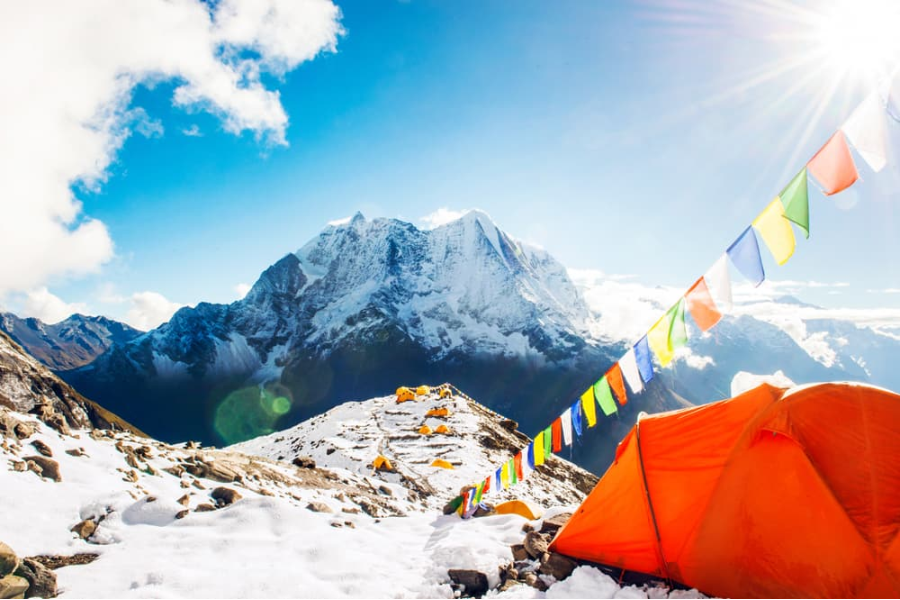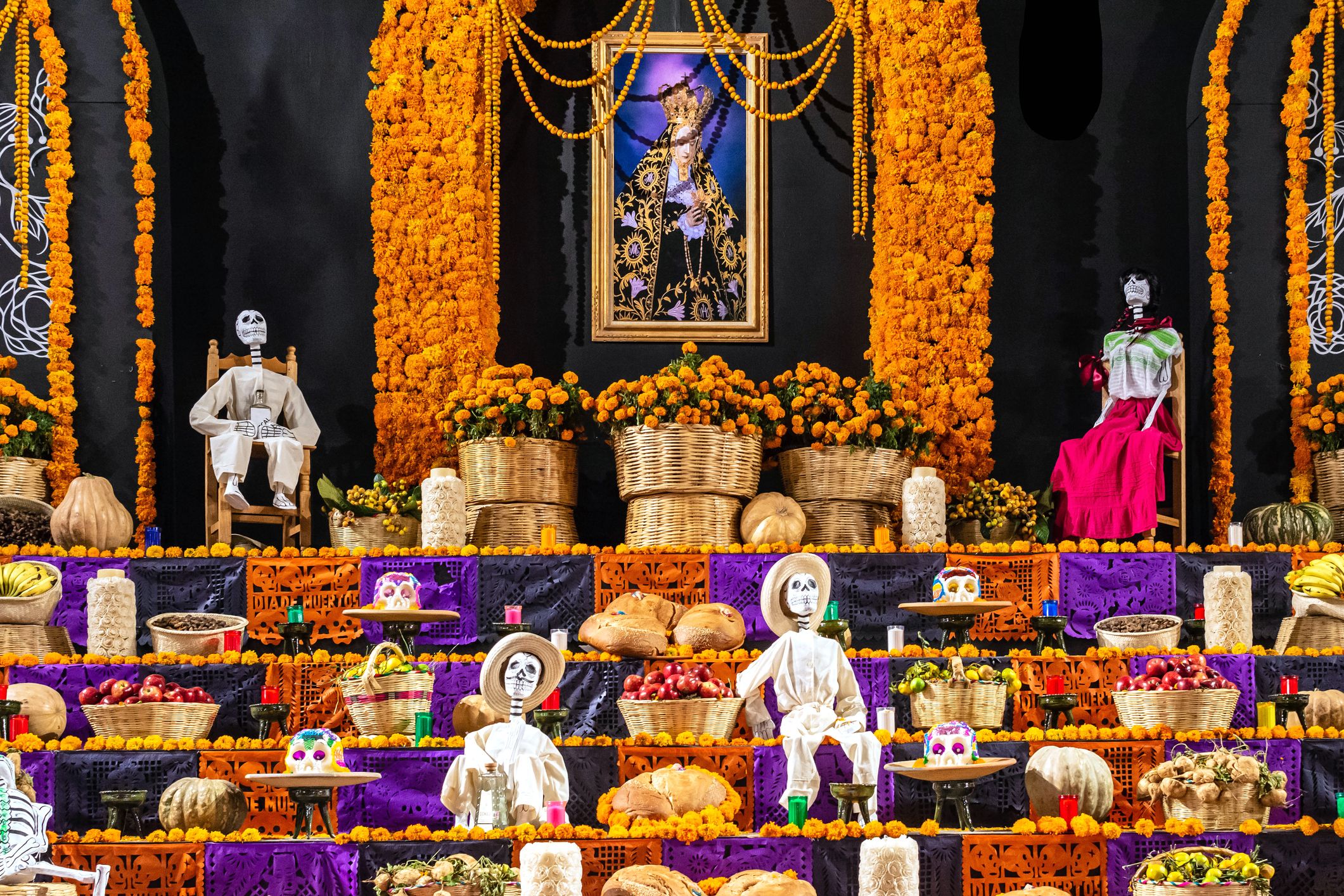Embarking on the Everest Base Camp and Gokyo Lake trek is a journey that combines the thrill of high-altitude adventure with the serene beauty of the Himalayas. This trek takes you through some of Nepal’s most spectacular landscapes, offering a unique blend of rugged mountain terrain, tranquil lakes, and rich cultural experiences.
The adventure begins with a flight from Kathmandu to Lukla, where the real trek starts. From Lukla, you’ll traverse a path that leads you through traditional Sherpa villages, lush forests, and rugged alpine terrain. The initial days are spent acclimatizing to the altitude in places like Namche Bazaar, which serves as the gateway to the Everest region. Namche’s vibrant market and local culture offer a fascinating introduction to the Sherpa way of life. As you continue, the trail winds up to Tengboche, known for its iconic monastery and panoramic views of the surrounding peaks.
The trek to Everest Base Camp is a highlight in itself, providing an intimate encounter with the world’s highest peak. Standing at the base camp, you’ll be surrounded by towering peaks and the dramatic Khumbu Icefall, an awe-inspiring spectacle of ice and snow. This part of the trek offers a profound sense of accomplishment and an opportunity to absorb the raw majesty of Everest.
After experiencing the grandeur of Everest Base Camp, the journey continues to the Gokyo Valley. This section of the trek is less traveled and offers a serene contrast to the bustling base camp. The Gokyo Lakes, a series of five glacial lakes, are renowned for their stunning turquoise waters and are set against a backdrop of snow-capped peaks and expansive glaciers. The trek to the Gokyo Lakes involves climbing to Gokyo Ri, a summit that provides breathtaking panoramic views of the Everest massif, including Everest itself, as well as Lhotse and Makalu. The sight of the Ngozumpa Glacier, the largest in the Himalayas, from Gokyo Ri is truly unforgettable.
Throughout the trek, you’ll encounter a diverse range of ecosystems and wildlife. From the lower altitudes where you might see Himalayan tahr and red panda to the high-altitude regions with their stark, dramatic landscapes, the trek offers a rich tapestry of natural beauty. The journey also includes interactions with the local Sherpa communities, where you can experience their hospitality, traditions, and unique way of life.
The Everest Base Camp and Gokyo Lake trek is more than just a physical challenge; it’s a journey through some of Nepal’s most breathtaking high-altitude scenery, offering a mix of adventure, tranquility, and cultural richness. It’s an experience that leaves a lasting impression, combining the thrill of trekking in the Himalayas with the serenity of its lesser-known but equally magnificent landscapes.
Introduction to the Journey
The Everest Base Camp and Gokyo Lake trek is a premier adventure that showcases the breathtaking beauty and diverse landscapes of Nepal’s Himalayas. This trek combines the iconic ascent to Everest Base Camp, a coveted destination for trekkers seeking to stand at the foot of the world’s highest peak, with the serene exploration of the Gokyo Lakes, a less-traveled but equally stunning high-altitude wonder. The journey begins with a thrilling flight from Kathmandu to Lukla, marking the start of an epic trek through traditional Sherpa villages, lush forests, and rugged alpine terrain. Over the course of 12 to 14 days, trekkers will experience a variety of landscapes, from the bustling town of Namche Bazaar to the tranquil Gokyo Valley, where turquoise glacial lakes and panoramic mountain views await. This journey offers a unique blend of adventure, natural beauty, and cultural encounters, making it a memorable and rewarding experience for those seeking to explore the heart of the Himalayas.
Trekking Route Overview
The trek to Everest Base Camp and Gokyo Lake follows a well-defined route that balances high-altitude adventure with cultural exploration. Starting in Lukla, the route first takes trekkers to Phakding and then to Namche Bazaar, the bustling gateway to the Everest region. From Namche, the trek continues to Tengboche, known for its scenic monastery and stunning mountain views. After reaching Everest Base Camp, the journey proceeds to the Gokyo Valley, traversing through Dingboche and Machhermo before arriving at the beautiful series of Gokyo Lakes. The trek includes an ascent to Gokyo Ri for panoramic views of the Everest massif, including Everest, Lhotse, and Makalu. The return route retraces the path back to Lukla, offering the chance to revisit scenic spots and experience the landscape from a different perspective. This route ensures a gradual ascent to aid acclimatization while providing ample opportunities to experience the diverse landscapes and cultures of the region.
Highlights of Everest Base Camp
Everest Base Camp Expedition is the pinnacle of the trek, offering trekkers an unparalleled view of the world’s highest peak. Standing at 5,364 meters (17,598 feet), the base camp provides a dramatic vantage point to witness the colossal Khumbu Icefall and the surrounding peaks. The area around the base camp is bustling with climbers and trekkers, creating a vibrant atmosphere filled with anticipation and adventure. The trek to Everest Base Camp includes passing through iconic landmarks such as the Hillary Suspension Bridge and the ancient monasteries of Tengboche and Pangboche. The views of Everest, Lhotse, and Nuptse from the base camp are awe-inspiring, and the experience of standing at the foot of this legendary peak is a profound and memorable accomplishment. Additionally, the base camp serves as a starting point for climbers attempting to summit Everest, adding to the allure and excitement of the destination.
Discovering Gokyo Lake
The Gokyo Lake section of the trek provides a tranquil contrast to the busy Everest Base Camp, offering a serene and scenic retreat amid high-altitude beauty. The Gokyo Lakes are a series of five stunning glacial lakes set against the backdrop of towering peaks and glaciers. The trek to these lakes takes you through the picturesque Gokyo Valley, passing through villages like Dole and Machhermo. The turquoise waters of the Gokyo Lakes, particularly Gokyo Lake itself, are strikingly beautiful and offer excellent photographic opportunities. The highlight of this segment is the ascent to Gokyo Ri, a summit that provides sweeping panoramic views of the Everest massif, including Everest, Lhotse, and Makalu, as well as the vast Ngozumpa Glacier. The tranquil setting of the lakes, combined with the breathtaking vistas from Gokyo Ri, creates an unforgettable experience that showcases the pristine and serene side of the Himalayas.
Best Times to Visit
The best times to embark on the Everest Base Camp and Gokyo Lake trek are during the pre-monsoon (spring) and post-monsoon (autumn) seasons. Spring, from late March to early May, offers clear skies, moderate temperatures, and the blooming of rhododendrons, providing an ideal environment for trekking. The weather is generally stable, enhancing visibility for the stunning mountain views and the turquoise lakes. Autumn, from late September to early November, also features clear skies and stable weather, with cooler temperatures that are favorable for trekking. During these periods, the trails are less crowded compared to peak seasons, and the weather conditions are generally reliable. Winter and summer are less suitable due to extreme cold and heavy snowfall or monsoon rains, which can affect trail conditions and accessibility. Choosing the right season ensures a more enjoyable and comfortable trekking experience, with the best opportunities to appreciate the natural beauty of the Everest region.
Packing Essentials for High Altitudes
When preparing for the Everest Base Camp and Gokyo Lake trek, packing efficiently is crucial for navigating the challenging high-altitude environment. Essential gear includes a well-fitted backpack to carry your belongings, trekking boots with good ankle support, and moisture-wicking clothing layers to adapt to varying temperatures. A high-quality down jacket and thermal base layers are vital for insulation against the cold, while a waterproof and windproof outer shell provides protection from harsh weather conditions. Other important items are a warm sleeping bag rated for cold temperatures, trekking poles to assist with stability on uneven terrain, and a sturdy water bottle or hydration system. Additionally, bring sun protection such as sunglasses with UV protection, sunscreen, and a hat to shield yourself from the intense high-altitude sun. Personal items like a first aid kit, high-altitude medications, and water purification tablets are also necessary for safety and health. Packing these essentials ensures you’re well-prepared to tackle the rugged terrain and unpredictable weather of the Himalayas while maintaining comfort and safety.
Necessary Permits and Regulations
To undertake the Everest Base Camp and Gokyo Lake trek, securing the appropriate permits and adhering to regulations is essential. The primary permit required is the Sagarmatha National Park Permit, which grants access to the protected area around Everest. This permit can be obtained at the park’s entry points or through trekking agencies in Kathmandu. Additionally, trekkers must obtain a TIMS (Trekkers’ Information Management System) card, which helps in tracking and ensuring the safety of trekkers. Both permits are crucial for entry and must be carried at all times. Regulations also include adhering to local guidelines for environmental conservation, such as following the “leave no trace” principles. It’s important to ensure all documentation is in order before starting the trek to avoid any issues with park authorities and to contribute to the preservation of the pristine Himalayan environment.
Acclimatization Techniques
Acclimatization is critical to successfully completing the Everest Base Camp and Gokyo Lake trek, given the high altitudes trekkers will encounter. The primary technique is to follow a gradual ascent plan, allowing your body time to adjust to the thinning air. This involves ascending slowly, typically not more than 300-500 meters (1,000-1,600 feet) per day above 3,000 meters (10,000 feet), and incorporating acclimatization days where you stay at a higher altitude but sleep at a lower elevation. Staying well-hydrated and eating a balanced diet also support acclimatization by maintaining your body’s overall health. Recognize symptoms of altitude sickness, such as headaches, dizziness, and nausea, and seek immediate medical advice if they worsen. Medications like acetazolamide can help with acclimatization, but they should be used under guidance. By adhering to these techniques, you reduce the risk of altitude-related illnesses and enhance your trekking experience in the Himalayas.
Daily Trekking Itinerary
The daily trekking itinerary for the Everest Base Camp and Gokyo Lake trek is designed to balance adventure with acclimatization and exploration. The journey begins with a flight from Kathmandu to Lukla, followed by a trek to Phakding on the first day. The second day involves a climb to Namche Bazaar, where you spend an acclimatization day to explore the area and adjust to the altitude. The trek then continues to Tengboche, known for its monastery and panoramic views. From there, you proceed to Everest Base Camp, spending a day to experience the base camp’s grandeur before heading to the Gokyo Valley. The route includes trekking through Dole and Machhermo before reaching the Gokyo Lakes, where an acclimatization day allows for exploration of the lakes and the climb to Gokyo Ri for panoramic views. The return journey retraces the route back to Lukla, culminating with a flight back to Kathmandu. This itinerary ensures a gradual ascent, providing ample time for acclimatization and appreciation of the region’s beauty.
Cultural Heritage of the Region
The Everest Base Camp and Gokyo Lake trek offers rich insights into the cultural heritage of the Khumbu region, home to the Sherpa people. As you trek through traditional villages like Namche Bazaar, Tengboche, and Dingboche, you encounter vibrant Sherpa culture, characterized by their unique customs, hospitality, and religious practices. The trek includes visits to ancient monasteries, such as the Tengboche Monastery, which play a significant role in the spiritual life of the local communities. The Sherpas are renowned for their deep connection to Buddhism, which influences their daily lives and festivals. Interactions with local families and staying in family-run teahouses provide opportunities to experience traditional Sherpa hospitality and cuisine. Additionally, the trek offers glimpses into the Sherpas’ traditional way of life, including their farming practices, craftsmanship, and the communal spirit that defines their communities. This cultural immersion enriches the trekking experience, offering a deeper appreciation of the region’s heritage and the people who inhabit it.
Breathtaking Landscapes and Views
The Everest Base Camp and Gokyo Lake trek is renowned for its breathtaking landscapes and stunning views, making it one of the most picturesque treks in the world. From the moment you embark on the journey, you are enveloped by the dramatic scenery of the Himalayas. The trek begins with views of lush green forests and traditional Sherpa villages, gradually giving way to the rugged, high-altitude terrain as you approach Everest Base Camp. Here, the sight of the towering Everest, along with the adjacent peaks of Lhotse and Nuptse, is nothing short of awe-inspiring. The trek to Gokyo Lakes introduces an equally spectacular landscape, featuring pristine glacial lakes of vibrant turquoise set against a backdrop of snow-capped peaks and vast glaciers. The ascent to Gokyo Ri offers panoramic vistas that include not only Everest but also Makalu and Cho Oyu, as well as the sprawling Ngozumpa Glacier. Each viewpoint along the trek reveals a new facet of the Himalayas’ grandeur, making the journey a continuous visual feast.
Wildlife and Flora of the Himalayas
The Everest Base Camp and Gokyo Lake trek passes through diverse ecosystems, showcasing the unique wildlife and flora of the Himalayas. In the lower regions, such as Phakding and Namche Bazaar, trekkers might encounter animals like the Himalayan tahr and red panda, as well as various bird species including the Danphe (Himalayan pheasant) and the Himalayan griffon vulture. As you ascend, the flora changes dramatically from lush green forests of pine and rhododendron to more sparse alpine vegetation. In the higher altitudes around Gokyo Lakes, the vegetation is limited to hardy shrubs and grasses adapted to the harsh environment. The trek also provides opportunities to observe the resilient life forms that thrive in these extreme conditions, including lichens and mosses that add a vibrant touch to the stark landscape. Understanding the region’s unique flora and fauna enhances the trekking experience, offering insight into how life adapts to high-altitude environments.
Safety Tips for High-Altitude Trekking
Safety is paramount on high-altitude treks such as the Everest Base Camp and Gokyo Lake journey. The key to a safe trek lies in proper preparation and awareness of altitude-related risks. Acclimatization is crucial; follow a gradual ascent schedule and incorporate rest days to help your body adjust to the thinning air. Monitor yourself and fellow trekkers for symptoms of altitude sickness, including headaches, dizziness, and nausea, and be prepared to descend if symptoms worsen. Hydration is vital—drink plenty of water to prevent dehydration, which can exacerbate altitude sickness. Carry a well-stocked first aid kit, including medications for altitude sickness, and ensure you have travel insurance that covers emergency evacuation. Trekking with a guide or in a group is recommended for added safety and support. Additionally, stay informed about weather conditions and be prepared for sudden changes that can impact trail safety. By adhering to these safety tips, you can mitigate risks and ensure a safe and enjoyable trekking experience.
Accommodations and Local Cuisine
Accommodations along the Everest Base Camp Trekking range from basic teahouses to more comfortable lodges, offering a variety of amenities and local flavors. In lower-altitude areas like Namche Bazaar and Lukla, you can find more modern lodgings with additional facilities, such as hot showers and electricity. As you ascend, the accommodations become more basic but still provide essential comforts, such as a warm bed and communal dining areas. The teahouses are typically family-run, and staying in them offers a glimpse into the traditional Sherpa lifestyle. The local cuisine is hearty and nourishing, featuring dishes like dal bhat (rice and lentil soup), noodles, and seasonal vegetables. In higher-altitude areas, the food options are more limited but still include basic Nepali and Tibetan fare. The communal dining experience allows trekkers to interact with fellow adventurers and enjoy a warm meal after a day on the trail. This combination of accommodation and local cuisine enhances the cultural experience of the trek.
Reflections and Travel Resources
Reflecting on the Everest Base Camp and Gokyo Lake trek reveals a profound sense of accomplishment and a deep appreciation for the natural and cultural beauty encountered along the journey. This trek not only challenges physical endurance but also offers opportunities for personal growth and memorable experiences amidst some of the world’s most spectacular landscapes. To further enrich your experience, various travel resources can be invaluable. Guidebooks such as “Trekking in Nepal” by Jamie McGuinness provide detailed information on routes, acclimatization, and cultural insights. Online forums and blogs offer firsthand accounts and practical advice from fellow trekkers. Websites like the Himalayan Database and trekking agencies specializing in Nepalese adventures can provide updated information on trail conditions and safety tips. Engaging with these resources helps in planning a well-prepared trek and ensures a smoother journey. Reflecting on the trek’s experiences and leveraging available resources will contribute to a richer and more informed adventure.





Leave a Reply